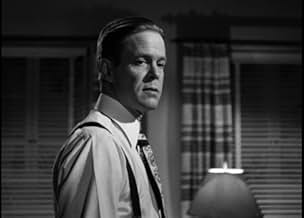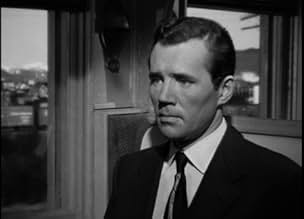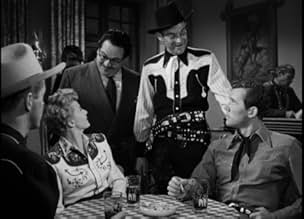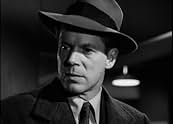Agrega una trama en tu idiomaUS Treasury agent George Morton persuades convicted criminal Johnny Evans to help him destroy a drug smuggling ring in exchange for early parole.US Treasury agent George Morton persuades convicted criminal Johnny Evans to help him destroy a drug smuggling ring in exchange for early parole.US Treasury agent George Morton persuades convicted criminal Johnny Evans to help him destroy a drug smuggling ring in exchange for early parole.
- Dirección
- Guionistas
- Elenco
- Joey Hyatt
- (as Anthony Curtis)
- McCandle's Secretary
- (sin créditos)
- Treasury Man
- (sin créditos)
- Ranch Guest
- (sin créditos)
- Pallbearer
- (sin créditos)
- Nightclub Patron
- (sin créditos)
- Courtroom Spectator
- (sin créditos)
- Nightclub Patron
- (sin créditos)
- Train Passenger
- (sin créditos)
- Dirección
- Guionistas
- Todo el elenco y el equipo
- Producción, taquilla y más en IMDbPro
Opiniones destacadas
This is a quick moving film that also stars a young Tony Curtis as a mute bodyguard/hit-man. All the cast do well with Dan Duryea being especially likable as a criminal who doesn't like cops. I have to admire his underhand ways as demonstrated when Duff doesn't allow him to go to the bar to meet Shelley Winters (Terry). Duryea takes advantage of a visit by McIntire to pick up his jacket and let Duff know that he's going to the bar by just walking out of the room leaving Duff powerless to do or say anything infront of a guest. We then see him sitting with Winters and enjoying himself. Good for him – nice move, Duryea! He plays by his own rules and keeps the viewer guessing as to whether or not he is going to betray Duff.
It's filmed on location in San Francisco and Arizona and has an ending that had me cheering!
To Castle's credit, he extracts very good performances from Duff, Winters, McIntire, Kelley and, especially, Dan Duryea, a con doing time who has sworn revenge against US Treasury agent Duff, but turns out to be more decent than imagined after seeing his wife killed as a consequence of consuming narcotics.
Soaring above the film's lofty acting standards, Duryea posts possibly his career-best show in a rare and surprising role as a seemingly inveterate baddie with a decent streak which ultimately redeems and finds him love and happiness. The revenge he warns Duff about turns out to be the wonderful woman who recognizes his worth in the end.
Winters and McIntire also deliver superb performances, the latter as the cold and calculating master villain. Interesting to note that the following year, 1950, Duryea, Winters and McIntire would re-assemble in one of the greatest Westerns ever, WINCHESTER '73.
As would a very young Anthony (Tony) Curtis, who in JOHNNY gets a small and wordless but crucial part as a baby-faced good for nothing... other than killing.
Cinematography deserves considerable praise throughout, the highlights being the early scenes at a dockyard, the apparent alacrity of all in a restaurant/dancing room, and the hangar at the end.
Chases and other action sequences are crackingly well staged, including the shootouts and, above all, the decisive plane-police car crash.
True, the script does not rise above some predictability, but then it is based on true FBI reports, and you know that good will win over evil. Thank God!
There is an international drug ring running from Mexico all the way to Vancouver. The federal authorities have some leads...but not much. So, to help them infiltrate this mob, George (Duff) arranges to have Johnny Evans (Duryea) released early from prison. The problem is George isn't very sure how far he can trust his new partner and they go undercover at a dude ranch outside of Tucsan, Arizona. Things get complicated when Johnny brings along a dame he feels sorry for (Shelley Winters), though having her along might easily jeopardize everything.
The film is mostly unremarkable but enjoyable. However, the movie really had a terrific ending--and this alone help elevate the movie above the ordinary. Well worth seeing.
Against his better judgment, he agrees to work with the police in exchange for his freedom. He hates Howard Duff, the federal agent who helped put him behind bars in the first place, but he has to work closely with him to plan a huge drug bust across the Mexican border. Shelley Winters goes with the pair, and while Dan is smitten, she only has eyes for Howard. Poor guy!
Check out this exciting crime flick to find out if she ever changes her mind. It's a great salute to Dan Duryea, and the story has some twists and turns you won't see coming. Plus, you'll probably recognize the mute, menacing villain even though he doesn't reveal his distinctive accent: young "Anthony" Curtis.
Those first two films were by the resourceful Anthony Mann; Johnny Stool Pigeon is by William Castle, no Mann but later to become the king of cheapie horror flicks after an apprenticeship in noir (his When Strangers Marry may be the best of his juvenilia).
It's a creditable if not especially memorable effort, thanks mostly to a cast headed by Dan Duryea, Howard Duff, Shelly Winters (in her sexpot phase) and, in a non-speaking part, young Tony Curtis (here billed as "Anthony," a better billing than he got in the same year's Criss Cross, where his manic rhumba with Yvonne De Carlo went uncredited).
Narcotics cop Duff knows his only chance to crack an international drug ring is by springing a convict (Duryea) whom he'd help put in Alcatraz. The oil-and-water team of unwilling partners travels from San Francisco first to Vancouver then, gang moll Winters in tow, to a dude ranch near Tucson run by the mob.
The plot's volatility depends on the possibility of Duff's being sold out by Duryea or recognized by Curtis, who spends half the movie knitting his brows in an effort to remember where he'd seen Duff before. Reckoning finally comes at a dangerous drug buy at the Nogales border crossing.
As a straight arrow, Duff's not bad, though in more ambivalent roles in movies like Shakedown or The Naked City, he can turn into a slithery chameleon. The reliable Duryea does his soured cynic number -- he had it down pat by now. Winters adds a dash of hot sauce, but it's a sketched-in part at best. Johnny Stool Pigeon adds up to a pretty routine hour-and-a-quarter of noir -- but that's far from faint praise.
¿Sabías que…?
- TriviaThe old plane seen outside the airport hangar at the end, was a captured Japanese Nakajima B5N ("Kate") Torpedo Bomber from World War II. It had been shot down at the attack on Pearl Harbor on December 7, 1941.
The plane had been sent to Arizona and stored at the Davis-Monthan Air Force Base, in Tucson, Arizona for warfare aeronautical studies during the beginning of the war. It was lent to the movie producers.
- ErroresNear the end, when Morton and the plane are on a collision course, we see through Morton's car window the plane has lifted off, and is about to clear the car, but when they cut to the crash, the plane hasn't left the ground.
- Citas
Terry Stewart: [in Canada, while Johnny and Terry are dancing] Where're you from, Johnny?
Johnny Evans: The States - California.
Terry Stewart: Ohh, California... you mean there's still a place where it's warm and got palm trees... and you can lie out in that lovely hot sun all the year round...
Johnny Evans: I guess so. You know California?
Terry Stewart: Uh-uh. Ah, I was brought up in Tucson - Arizona. Wish I'd never left it. Been in this dump for 2 years. The only time I've ever been warm was once I went to sleep with a cigarette and I set the bed on fire.
- Créditos curiosos[prologue] In their never-ending task of law enforcement, the officers of the Bureau of Narcotics and the Bureau of Customs of the United States Treasury fight many battles such as the one you are about to see. Their successes are a tribute to their skill, intelligence and courage. To their fearless officers we respectfully dedicate this picture.
- ConexionesReferenced in Johnny Staccato: An Angry Young Man (1960)
Selecciones populares
- How long is Johnny Stool Pigeon?Con tecnología de Alexa
Detalles
- Fecha de lanzamiento
- País de origen
- Sitios oficiales
- Idiomas
- También se conoce como
- Johnny Stool Pigeon
- Locaciones de filmación
- Productora
- Ver más créditos de la compañía en IMDbPro
- Tiempo de ejecución
- 1h 16min(76 min)
- Color
- Relación de aspecto
- 1.37 : 1



















